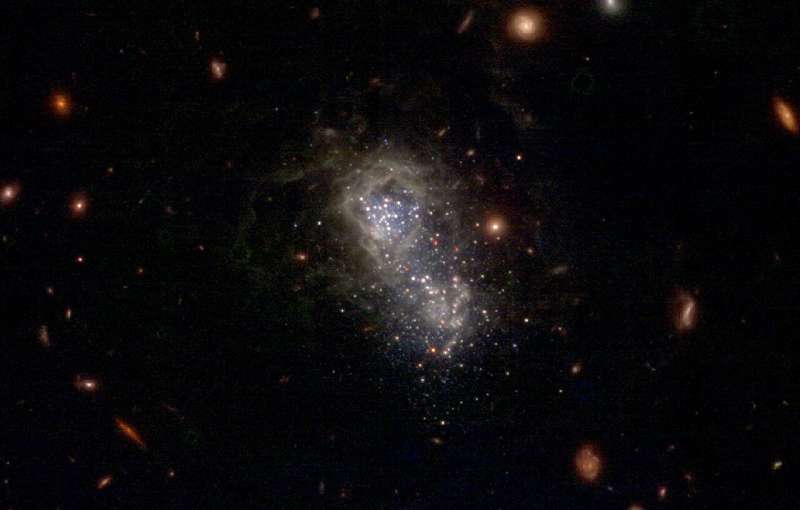March 21, 2024 report
This article has been reviewed according to Science X's editorial process and policies. Editors have highlighted the following attributes while ensuring the content's credibility:
fact-checked
preprint
trusted source
proofread
Astronomers explore stellar populations of an extremely metal-poor dwarf galaxy

Using the James Webb Space Telescope, astronomers have conducted near- and mid-infrared observations of an extremely metal-poor blue compact dwarf galaxy known as I Zwicky 18. Results of the observational campaign, presented in a paper published March 11 on the arXiv preprint server, deliver important information regarding stellar populations in this galaxy.
Blue compact dwarfs (BCDs) are low-luminosity and low-metal content dwarf galaxies experiencing violent bursts of star formation. They are characterized by a compact optical appearance and H II-region-like spectra due to highly concentrated starburst activities.
I Zwicky 18 is the archetypal BCD located about 59 million light years away in the constellation Ursa Major. This BCD is one of the most extremely metal-poor galaxies known as it is almost exclusively composed of hydrogen and helium.
Previous observations have found that I Zwicky 18 is currently experiencing a period of intensely elevated star-formation rate (SFR) and may be still creating Population III stars—hypothetical extremely massive stars, poor in elements heavier than helium, believed to have been formed in the early universe. Hence, this galaxy is perceived as an ideal laboratory to study both the young and evolved star demographics in an environment analogous to that found shortly after the Big Bang.
That is why a team of astronomers led by Alec S. Hirschauer of the Space Telescope Science Institute (STScI) in Baltimore, Maryland, decided to take a closer look at I Zwicky 18. They employed JWST's Near Infrared Camera (NIRCam) and Mid-Infrared Instrument (MIRI) to investigate the stellar content of this galaxy.
The observations conducted by Hirschauer's team identified extreme populations of bright, recently formed massive stars in I Zwicky 18, located predominantly among the galaxy's two central lobes of star formation—the northwest (NW) and southeast (SE) components. The obtained images also show large supershells of dust and ionized gas carved out by previous star formation and supernovae activity.
The collected data allowed the astronomers to detect candidate populations of dusty evolved stars (red supergiants and asymptotic giant branch stars) in I Zwicky 18, alongside bright young stellar objects (YSOs). The researchers estimated the tip of the red giant branch (TRGB) and divided those sources that lie above it into left- and right-branch populations, related to younger (upper main sequence, UMS stars) and older (evolved) stars, respectively.
According to the authors of the paper, their findings suggest that the prevailing demographics of I Zw 18's NW and SE star-formation regions reflect that of younger and older stellar populations. The study also proves how important is JWST in investigating dusty and evolved stars in compact dwarf galaxies in the early universe.
More information: Alec S. Hirschauer et al, Imaging of I Zw 18 by JWST: I. Strategy and First Results of Dusty Stellar Populations, arXiv (2024). DOI: 10.48550/arxiv.2403.06980
Journal information: arXiv
© 2024 Science X Network




















